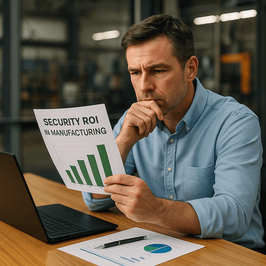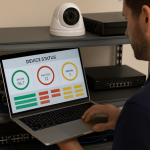
Upgrading security systems in a manufacturing facility often feels like a tough sell. Plant managers, safety directors, and operations leads may recognize the need for better surveillance, smarter access control, or integrated emergency systems—but convincing finance or leadership to green-light the spend? That’s another story.
Security, after all, rarely shows up on a P&L statement—until something goes wrong.
But here’s the truth: modern physical security systems don’t just reduce risk—they actively create operational and financial value. In this post, we’ll break down how to build a compelling case for security investment, backed by real manufacturing-specific ROI drivers your budget team will respect.
k
k
📉 The Problem: Why Security Upgrades Get Delayed
Security is often perceived as:
-
A cost center, not a productivity driver
-
Only necessary after an incident
-
“Nice to have,” but lower priority than production upgrades
This leads to:
-
Reliance on outdated or disconnected systems
-
Hidden costs (manual workarounds, false alarms, inefficiency)
-
Vulnerabilities that threaten uptime, safety, and compliance
The fix? Learn to speak in terms leadership understands: risk mitigation, operational value, and measurable ROI.
k
k
📈 1. Calculate the Cost of Downtime—Then Connect the Dots
For many manufacturing plants, every minute of downtime equals thousands of dollars lost. Security breaches, false fire alarms, unauthorized zone access, or incident investigations can all slow or stop production.
Use this framework:
Average hourly downtime cost × average incident length × incidents per year = preventable loss.
Example:
If your plant loses $8,000 per hour during a halt and your outdated surveillance system causes 3 unnecessary shutdowns a year due to false alarms or delayed verification, that’s a $24,000+ annual hit.
Security ROI opportunity: Advanced video monitoring with real-time alert filtering and verification.
k
k
🧠 2. Highlight Labor and Oversight Savings
Ask:
-
How many hours are your team spending reviewing video footage manually?
-
How many people are issuing or revoking badges across shifts?
-
Are you still doing visitor logs by paper?
Modern security systems save time and labor:
-
Integrated access control reduces admin workload
-
Cloud-based systems cut travel or onsite adjustments
-
Automated reporting supports audits and compliance in seconds
This creates hidden operational savings that compound over time.
k
k
🛡️ 3. Quantify Risk Reduction and Insurance Impact
Insurance providers love physical security upgrades. Why? Because:
-
Stronger perimeter protection reduces liability
-
Surveillance reduces fraudulent claims
-
Access control logs support incident investigations
Facilities with:
-
Camera coverage
-
Access logging
-
Integrated alarms
May qualify for lower premiums or better coverage terms.
Pro tip: Ask your insurer for a risk-based discount estimate after implementing an upgrade. Include that figure in your ROI pitch.
k
k
🔁 4. Show Lifecycle Value, Not Just Upfront Costs
A security system upgrade isn’t just a one-time expense—it’s a 5–10 year investment that:
-
Prevents incidents
-
Lowers admin overhead
-
Streamlines emergency response
-
Helps you pass audits with less rework
If a $50,000 investment prevents just one major breach or shutdown over 7 years, it likely pays for itself several times over.
Frame your pitch like this:
This is a proactive investment that will support safety, productivity, and compliance every day—not just during emergencies.
k
k
📊 5. Bring Data to the Table
You don’t need to guess. Show:
-
Incident reports where better tech could’ve reduced time or impact
-
Log inconsistencies or bottlenecks in access control
-
Camera blind spots that slow incident reviews
-
Time spent handling preventable alarms or errors
This grounds your case in real plant conditions, not hypotheticals.
k
k
🏁 Final Thoughts: Build the Case for Security Like You’d Build a Machine
Security doesn’t have to be an emotional ask—it can be an operational improvement with measurable return.
When pitching security upgrades to your manufacturing leadership:
-
Tie every feature to productivity, protection, or prevention
-
Present real data from your facility
-
Position upgrades as tools for resilience and readiness, not just reaction
👉 Want to explore high-impact security upgrades that align with your budget and operations?


